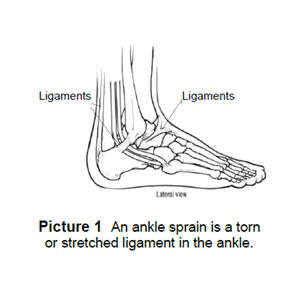Sports Medicine: Ankle Sprain


Ligaments are the tissues that connect bone to bone. An ankle sprain is a torn or stretched ligament in the ankle (Picture 1). Signs of an ankle injury include pain, swelling and tenderness in the ankle that may spread to the whole ankle and foot, and trouble walking. A pop or feeling of tearing at the time of injury may be another sign.
Acute ankle sprains are often the result of a quick shifting movement with the foot planted, such as a fall or sudden twist. Commonly, the ankle will roll outward and the foot will turn inward.
Increased Risk
- previous ankle sprains
- activities where the foot may land wrong (like basketball, volleyball and soccer)
- shoes with not enough support to prevent sideways motion when stress occurs
- poor physical conditioning (strength, flexibility and balance)
- foot with a high arch
Treatment
- Medicine
- Nonsteroidal anti-inflammatory medication, such as ibuprofen (Motrin® or Advil®) is used to reduce swelling. Take these as directed by your health care provider.
- Other minor pain relievers, such as acetaminophen (Tylenol®), may be used.
- Use of heat and cold
- Cold is used to relieve pain and reduce swelling. Cold should be applied for 10 to 15 minutes every 2 to 3 hours and after any activity that makes symptoms worse. Use ice packs and ice massage or cold compressive wrap.
- Heat should not be used on an acute injury but may be used before stretching and strengthening activities prescribed by your health care provider. Use a heat pack or a warm soak.
- Compression and raising the foot may also help reduce pain and swelling
- Orthopedic aids
- A walking boot or brace may give support to the joint.
- Crutches may be used for different amounts of time. The time will depend on the injury.
After the swelling and pain improve, getting motion, strength and balance back in the ankle is important to return to normal. Range-of-motion, stretching and strengthening exercises may be done at home. A referral to a physical therapist or athletic trainer is advised.
Ankle sprains may take several weeks to several months to heal. Usually, the more pain and swelling, the more severe the ankle sprain and the longer it will take to heal.
How to Prevent
- warm up and stretch well before practice or competition
- maintain good conditioning, ankle and lower leg flexibility, muscle strength and endurance, cardiovascular fitness and balance
- taping, bracing or shoes with ankle support may prevent injury
When to Call the Health Care Provider
Call your health care provider or the Sports Medicine team at 614-355-6000 if:
- pain, swelling or bruising worsens despite treatment
- you feel pain, numbness or coldness or see discoloration in the foot or toes
- you have other new symptoms
HH-I-485 Copyright 2021, Nationwide Children’s Hospital
